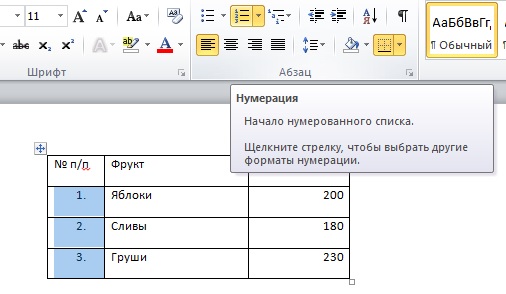Abbreviation rules
A variety of documents use certain types of abbreviations. All of them must meet the requirements of the rules of spelling and punctuation. The rules for abbreviations in the texts of business papers are determined by the state standard. Abbreviations are justified because they shorten the time for compiling the text, reduce their volume and, of course, the cost of producing a document.
Set worksheet and cell options
To deselect multiple worksheets, click any unselected worksheet. If you don't see the selected worksheet, right-click on the tab on the selected sheet and select Unpack Sheets. When you enter or edit data, changes affect all selected sheets and may inadvertently replace data that you do not intend to change. To avoid this, you can view all sheets at once to see potential data conflicts. Go to a new window and select the worksheet you want to view. Repeat steps 1 and 2 for each worksheet you want to look at. On the View tab, in the Window group, select Assign All, and then click the option you want. To view only the worksheets in the active workbook, check the " Active Books workbook". On the View tab, in the Window group, click New Window. . Some changes affect all workbooks, some affect the entire worksheet, some only affect the cells you specify.
Abbreviations are an economical designation of words in documents. Their peculiarity is that they are pronounced in oral speech in full and abbreviated only in writing. After such an abbreviation, a dot is necessarily put if it is not kilograms or a metric measurement: (kg, t, mm, km, dm, g).
The main reduction criterion is availability.
Changing this setting affects the entire worksheet, all other open worksheets, and all new workbooks. This can happen if the cell contains a number or a date, and the column width cannot display all the characters required by its shape. However, the column must be only six characters long to display.
Multiple line text in a cell
To see the full contents of a cell with its current format, you need to increase the column width. As an alternative to increasing the width of a column, you can reshape that column or even an individual cell. You can display multiple lines of text in a cell by dragging text across multiple lines. Translating multiple strings into a cell does not affect other cells.
There are two types of abbreviations: a) for visual perception; b) for use in writing.
Graphic abbreviations for visual perception do not have grammar, denoted by small letters, are written:
- through an oblique line: o / c (special composition), v / h ( military unit), p / n (serial number), etc.
- through a hyphen: m-ts (month), library (library), district (district), function (function), etc.
It is customary to distinguish between several types of abbreviations:

This display difference can have significant implications when the data is numeric. For example, when the number you entered is rounded up, the displayed number is usually rounded up. The calculation uses the actual number that is stored in the cell, not the formatted number that is displayed.
Formatting a number as text
Therefore, calculations may be inaccurate due to rounding in one or more cells. After entering numbers in a cell, you can change the display format. If we have a long list of Customers, products, friends, digital assets or others, but we are not sure if we have duplicated any entry. Checking and removing duplicates is easy and fast. The list may not be alphabetical order. Validation is the same as repetition, regardless of whether the names are in lowercase or uppercase letters. But if there is a typo in one name, it does not appear as a repetition.
- Letter (initial) abbreviations (abbreviations), which are formed from the initial letters of each word: Ministry of Internal Affairs, GAI, Chernobyl, SBU, Main Directorate of the Ministry of Internal Affairs, etc. Almost all initial abbreviations are written with capital letter(with the exception of those that have become independent words, for example, registry office, university, etc.).
2. Compound abbreviated words of mixed education consist of abbreviations and truncated words. They are written in different ways, for example, VNIIugol, district, etc.
However, it is imperative that the list take precedence. Validation will be done with an example list of names and numeric values. Here Petar Petrov and Stoyan Stoyanov are intentionally spelled differently to prove the correctness of finding duplicate entries. This example adds two blank lines to add names. In the second part of the formula, we can put different texts for the presence or absence of repetitions or numbers.
Where texts are written, they should always be indicated and figures are not attached. As a result, we get the following. If in the 14th order we write again, Petar Petrov will appear on line 13 "Repeat". Similarly, we use the column numerical value.
Z. Compound words complex type, for example, a collective farm, a state farm, a ship, Rostselmash, Glavmorput, etc.
4. Separate, partially abbreviated words, consisting of a part of the stem and the full word, differ in some features in decoding, in the category of gender, declension, for example: head of staff, deputy director, main post office, etc.
We found duplicates, now we will remove them. This way you don't have to look at the last line in long list. Even with a formula that is in the text, it is directly covered by the entire table. So both formulas can use. Once duplicate entries are duplicated, how are they removed so that one of them remains active because all entries are removed?
All values that are unique take 1, repeats. You can leave the cell blank with 0 instead of 1 to write specific text. The formula determines the first metric value and gives it 1, and each subsequent iteration gives it. It extracts unique values from each area.
5. Borrowed from other languages, for example: BBC, APN, napalm, lavsan, etc.
6. Conditional graphic abbreviations for designating positions, geographical concepts, periods of time, quantitative definitions, names of cities, villages, villages, regions, districts, streets, avenues, etc.
The peculiarity of graphic abbreviations is that they are not pronounced in oral speech. After such an abbreviation, a period is necessarily put, for example: city (city); With. (village); region, district, etc. Graphic abbreviations are always written in lowercase letters.
You can insert empty cells above or to the left of active cell on the sheet. This will move the remaining cells in the same column down or one row to the right. Likewise, you can insert rows above an existing row and a column to the left of an existing column. You can also delete cells, rows and columns.
In the "Insert or remove a worksheet" section. Insert empty cells into a sheet. To paste cells containing data and formulas, copy or cut them, right-click the location where you want to paste, and then choose Paste Copied Cells or Paste Counted Cells from the context menu. You can use the quick view button to set the formatting of the pasted cells. Pasting cells into a sheet will result in the corresponding match. This is true whether they are relative or absolute.
The requisites "title", "author of the document", "signature" are not reduced in the ORD. It is not allowed to abbreviate words through an oblique line, because this method is not provided, for example: n / factory (at the factory), m / mother (mother of many children), s / r (honored innovator). General accepted abbreviations used in enumerations and references, with poisonous numbers, names, surnames, for example, etc. (and so on), etc. (and the like), etc. (and so on), etc. (and others), 1 million, 50 km, etc.
A similar match occurs when cells are deleted, unless there is a formula that refers directly to the deleted cell. If the link is to be matched automatically, it is recommended to use scopes rather than individual cells. You can use the quick parse button to format inserted rows. You can use the quick parse button to format the inserted columns. Delete cells, rows or columns.
On the Home tab, in the Cells group, click the arrow next to Delete, and then do one of the following: To delete selected cells, click Delete Cells. To delete selected rows, click Delete List Rows. To remove selected columns, click Remove Sheet Columns. You can right-click on a range of cells, click "Delete" on the context menu, and select the option you want. You can also right-click a range of rows or columns and then click "Delete" from the context menu.
- Select the cells, rows or columns you want to delete.
- To deselect cells, click any cell on the sheet.
- Below in this section.
The union "that is" (i.e.), is abbreviated, and the words "because", "thus", "because", "so-called" should not be abbreviated.
The names of academic degrees, titles can be abbreviated immediately before the surnames both in the text and in the requisite "signature", for example: acad. Zakharov, Assoc. Petrov, Ph.D. tech. Sciences Leonov, engineer. Ivanov and others. The title of the position may be abbreviated only in the text, for example: "Chief Mechanic L.P. Silaev spoke at the meeting." Moreover, the words "deputy", "head", "assistant" are written together (head of department, head of warehouse, assistant director). But if these words are separated from the noun by an adjective, then a period is placed after them: for example, deputy. chief engineer.
After deleting rows or columns, the remaining rows or columns will automatically move up or to the left. Pressing the Delete key only deletes the contents of the selected cells, not the cells themselves. If necessary, you can restore data immediately after deletion. . Select cells, ranges, rows or columns.
Do you have a question about a specific feature?
If you want to send personalized emails to multiple recipients, use mail merge. You can create a batch of personalized, identically formatted emails that use the same text and graphics. Only certain sections Email will be personalized and will be different. Mail merge - as opposed to sending messages to a group of people - makes each recipient of a message a single recipient.
Geographical concepts are abbreviated only before the words to which they refer, for example: lake. Balaton, Donetsk.
When writing the address in the requisite "addressee" it is allowed to abbreviate: st. (street), ave. (avenue). per. (lane), pl. (area), d. (house), bldg. (body), sq. (apartment), reg. (region), pos. (village). Reductions in time intervals and quantitative definitions are allowed after numerals expressed in numbers: 5 thousand wagons, 12 thousand head of cattle, 200 gr.
Preparation of the main document
Preparing an email using the mail merge process includes three documents. Main document This document is an e-mail message that contains text and graphics that are identical to each version of the merged document. Address List This document contains the data used to populate the information in the message. The address list includes, for example, the names of the people to whom the email contained in the main document is addressed. Integrated document This document is a combination of a main document and an address list. Mail merge extracts information from a mailing list and puts it into main document, which results in a personalized merge merge document for each person on the mailing list. For example, if you want to inform your audience about an upcoming event, include the name, date, time, and location of the event in the message.
The word "year" is abbreviated only with numbers, for example: 1992.
When designating a period of time, they write like this: 1990-1995, but if there is a preposition "by" between years, then you should write: from 1990 to 1996.
When designating the accounting economic and administrative budget of the years, they write 1995/96 academic year, - in other cases, 1995/96 (if the year is administrative, economic, educational, budgetary).
Mailing list setup
Such event details must be known to all recipients. 
The address list is the data source.
Connect a list of addresses to an email message
It's time to select recipients from the data source. Make sure the data source contains a column with the recipients' email addresses, and each person you want to send a message to is assigned an email address.On the Matching tab, in the Merge Merge group, select Select Recipients and select the appropriate option. Do one of the following: If you don't have an address list, select Enter new list' and create it. Then go to your list and select "Open". . Enter a name for the file in the File Name field and click Save.
When writing a date in a mixed way (verbal-numeric and alphabetic), the word "year" is written with the letter y, for example, May 22, 1996. When the name of the month and year are combined, the word "month" is not written: (in October 1995). Do not write in the text "in October this year." (this year), you must specify the year in full: in October 1995.
When calculating time in documents, they write 20 hours or 20-00, 8 hours 45 minutes, the word "morning" and "day" should not be used.
If you are sending an email to everyone on the list, go to the Add Personalized Content to Email Step. If you want to send an email only to selected people in the list, you can narrow down the list by following the steps in Editing the address list.
View preview and exit

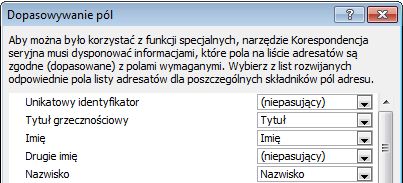
Format mailboxes. To change the font, size, or spacing of the merged content, select the merge field name and make the appropriate changes. 
After adding the merge fields to the main document, you can view the results of the merge. If preview meets your expectations, you can complete the merge.
The words "hour", "minute", "second" are abbreviated with numbers, for example: - 5 h 32 min 20 s (no dot at the end of the abbreviations).
Signs №, §, % in the text are put only with numbers, and in plural they are not doubled, for example, No. 16, 6, 9, § 7, 10, 12, 50-60%.
Only officially accepted abbreviations for the names of institutions and organizations should be used, for example: Ministry of Coal Industry, Ministry of Education, etc.
Abbreviated names of brands of machines, mechanisms, machine tools, tools, etc., consisting of separate alphabetic or mixed (alphabetic and digital) indices, must be written without quotes in capital letters. In such abbreviations, the numbers, if they are after the letter indices, must be separated by a hyphen, for example: GAZ-51, VAZ-69.
If letter designations stand after the numbers, then the entire index is written together, IL-18D.
Nowadays, abbreviations are very often used in the field of office work. Many of them have become commonly used and entered into lexicon people as full-fledged lexical units. They are constantly used in various styles written speech, including in the official business style.
Writing numbers
In business papers, you constantly have to deal with a significant number of numerical names. They demand special design. When compiling documents, you should remember the rules for recording digital information.
So, unambiguous quantitative numerals (answer the question "how many") do not have case accretion, for example, in the attribute "application" the number of sheets and copies is written only in numbers: for 3 liters in 2 copies. (not written in 5, in 3). If the number has an abbreviated dimension, it is written only in numbers: 8 kt, 5 l, 25 km, etc., but if the numbers do not have units of measurement in the text of the document, they are written only in words, for example: in one direction, with three bolts, etc. (except for compound numbers: 21, 35, 198, etc.).
Numbers starting from tens of thousands are written in a mixed way: 15 million. people, 20 thousand hryvnias, 200 thousand copies, but uniformly within one text.
Ordinal numbers expressed in Roman numerals case endings do not have, for example: at the IV session of the Supreme Council of Ukraine. Ordinal numbers do not have extensions if they come after a noun, for example: fig. 2, damn. 2, on p. 41. If several (more than two) ordinal numbers stand side by side, case accretions are placed only with the last one, for example: 1, 2, 3rd, etc.
Compound words, the first part of which is a numeral, are written in a mixed way, with a hyphen (without case extensions), for example: 200 tons, 300 years, 40 mm, 12 volumes.
Units of measurement for numerals denoting the limit are written only once: 20-30 pieces, or from 20 to 30 pieces.
Monetary amounts are written as follows: first, the amount is indicated in numbers, and in brackets - in words, for example: in the amount of 256 UAH. (two hundred and fifty six hryvnias).
If the text of the document contains a number of numerical values of a quantity expressed by the same unit of measure, then this unit of measure is indicated only after the last digit.
The intervals between the numerical value of the quantities are written as follows: from 50 to 100, from 100 to 150.
The digital material placed in the document is recommended to be presented in the form of tables (note 2.1). Table design rules
A table is a list of information about something or about numerical data given in a certain system and arranged in columns. The table allows you to provide information about the most compact and visual form. Requirements for the construction, presentation and design of tables are set out in the GOST 1.5-85 section. Although GOST is devoted to the construction of standards, the requirements for tables set forth in it apply to all unified documentation systems, including organizational and administrative. It states that “tables are used for better visibility and comparison of indicators”.
GOST names the mandatory elements of the table and the order of their graphic arrangement (Table 3.1)
Table 3.1
Thematic title (may not be)
Count headings | |||||||||
Subheadings Count | |||||||||
Lines (horizontal- rows) |
|||||||||
Sidebar (line headers) | Graphs (columns) | ||||||||
All tables in the text, including those in appendices, are numbered consecutively. Arabic numerals. If there is only one table, then the word “Table” is not written and, therefore, the numbering is not put down.
A table may have a title that briefly but accurately reflects its content. It is written above the table in the middle with a capital letter. There is no dot at the end of the title. The head of the table is separated by a bold line from the rest of the table. The bounding lines on the left, right and bottom do not close the table. The table is placed immediately below the text where it is first mentioned, or on next page. You can give a table in the annexes to the main document. If the table is large and its rows and columns do not fit on the page format or it is transferred to another page, then it can be divided into parts that fit one under the other. Above each next part they write “Continuation of the table ...”, repeat its head, and, if necessary, the headings of the lines.
The headings of the columns and lines are written with a capital letter, the subheadings of the columns are lowercase if they serve as a continuation of the heading, and with a capital letter if they have independent values (Tables 3.2, 3.3)
Table 3.2
Table 3.3
Do not put a dot at the end of the heading and subheading of the table. Column headings are always formulated in singular and the nominative case.
A common mistake in the design of tables is the diagonal division of rows. A special paragraph of GOST indicates that it is not allowed to separate the headings of the sidebar and the graph with diagonal lines, and it is also impossible to include the column “Order number” in the table. If there is a need to number the indicators, then their serial number is placed in the sidebar of the table immediately before their name (Table 3.4).
Table 3.4
It should be noted that when designating brands, types of products, as well as in front of the numerical values of the quantity, the serial number is never affixed.
GOST describes in detail the designation procedure physical quantities and their numerical value, so it should be at hand for everyone who draws up such tables.
The numerical values of the indicator should be entered at the level of the last line of the indicator name. In the case when indicator values are disclosed in the form of text, the entry should begin at the level of the first line of the indicator name. In the absence of data in the table, a dash (dash sign) is put (Table 3.5)
Table 3.5
The rules for filling in the indicators are presented in Table. 3.6.
Table 3.6
If within one column the text consisting of one word is repeated, and there are no horizontal lines in the table, then this word is replaced with quotation marks (Table 3.6)
Table 3.6
Repetitive figures, mathematical records of the designation of material grades are not allowed to be replaced with quotation marks.
If the repeated text consists of two or more words, at the first repetition they write the word “The Same” and then put quotation marks. They do the same when repeating part of the word, supplementing additional individual information (Table 3.8)
Table 3.8
If the rows in the table are separated horizontal lines, the text is repeated completely (Table 3.9)
In this article, I will tell you what you do not pay attention to in the table. Many tables have a serial number column. This column indicates what number this or that line is under. Many do not know that this column can be configured so that it will automatically number all lines. Some will say “why, I myself do an excellent job with this task.” But the truth is that this approach is not practical. Such a statement can only be made by a person who has not had to add a new row or delete an existing one from the table.
Really, given task becomes difficult if you change the number of lines in big table. You need to rewrite the number right away. I suggest you learn how to make Word independently number the rows in the table.
Let's say we have empty table, its first column is the number in order.
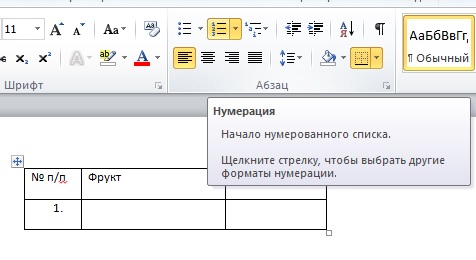
Now, when we add a new row, the first column of that row will be filled with the corresponding row number.
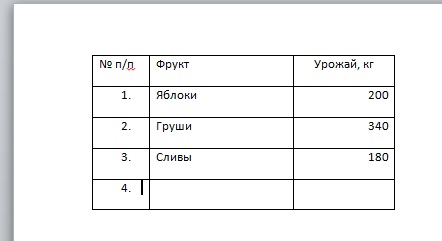
Well, now attention! What needs to be done automatic numbering first column. Let's remove the second line, with data about pears.
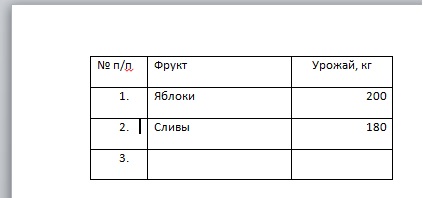
As you can easily see, the sequence number for the line with data on drains has changed automatically.
I want to remind you that this approach is very relevant when you have to work with large lists. For example, a list of employees or students. In such lists, it is important to note not only, but also the correct serial number. After all, these lists are subject to change.
And now, I want to tell you how to number the entire column in an existing table. Select the cells of the column in which you want to put down the row numbers. And as you may have guessed, click on the numbered list button.
